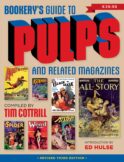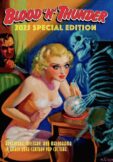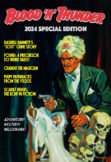EDitorial Comments
Ruminating On The Nature Of Pulp
The other day, while scanning social-media sites and hobbyist message boards, I was struck by the proliferation of books currently being marketed as “pulp.” This, of course, is not an altogether new phenomenon: Although the rough-paper periodicals of yore ceased publication more than 50 years ago, the “pulp fiction” label has since been routinely attached to hardcover novels, paperback originals, and short stories written primarily for the few remaining all-fiction magazines devoted to crime, horror, and science fiction.
But there was an unfortunate byproduct to this practice. The definition of “pulp” became increasingly elastic — amorphous, even. Today, the term is used to describe movies, music, comics, television shows, and even fashion. In some circles “pulp” is used indiscriminately as a synonym for such words as “outré” and “transgressive.” In some cases it’s employed to convey an attitude.
Of course, “pulp” always had multiple meanings. However, the word’s cultural cachet derived from its function as a descriptor of periodicals printed on woodpulp paper and published during a specific period of time. For many decades, that was the easily understood and clearly recognized meaning of “pulp.” But not any more.
Pulp fiction — that is, fiction published in pulp-paper magazines during the first half of the 20th century — is much more difficult to identify than many people believe. Qualitatively speaking, there was a world of difference between stories printed in the better magazines (Adventure, Blue Book, and The Popular Magazine) and those printed in the industry’s low-end titles (say, anything published by Louis Silberkleit’s Columbia Publications and Double-Action Group). Differences among other magazines and publishing houses were subtler, of course, but on the whole there’s no easy way to describe or characterize pulp fiction. Therefore, one can be forgiven for adopting the standard famously championed during an obscenity case by Supreme Court Justice Potter Stewart, who found himself unable to define hard-core pornography but declared, “I know it when I see it.”
By now you’re wondering if there’s a point to my rambling. I guess it’s more a question than a point, but it has to do with attaching the “pulp” label willy-nilly to books that might or might not bear any similarity in tone, style, or content to the rough-paper magazines cherished by hobbyists and readers of Murania Press products. Recent postings to Internet sites have trumpeted the publication of tomes categorized as Poker Pulp, Black Pulp, and even Children’s Pulp. Without casting any aspersions on the respective books that make up these categories — which, for all I know, are exemplary products — I have to wonder if the meaning of “pulp” hasn’t become too amorphous. Does it still have any meaning, or has it been reduced to a marketing buzzword calculated to provoke a Pavlovian response? To paraphrase a wise man: “If everything is pulp, nothing is pulp.”
I think this is a subject for further rumination. What do you think? As always, your comments are welcome.
21 thoughts on “Ruminating On The Nature Of Pulp”
Leave a Reply
Recent Posts
- Windy City Film Program: Day Two
- Windy City Pulp Show: Film Program
- Now Available: When Dracula Met Frankenstein
- Collectibles Section Update
- Mark Halegua (1953-2020), R.I.P.
Archives
- March 2023
- July 2021
- May 2021
- March 2020
- February 2020
- December 2019
- November 2019
- October 2019
- September 2019
- August 2019
- May 2019
- April 2019
- March 2019
- February 2019
- December 2018
- November 2018
- October 2018
- August 2018
- June 2018
- February 2018
- December 2017
- October 2017
- September 2017
- August 2017
- May 2017
- April 2017
- February 2017
- September 2016
- August 2016
- July 2016
- June 2016
- November 2015
- October 2015
- September 2015
- August 2015
- July 2015
- June 2015
- May 2015
- April 2015
- March 2015
- February 2015
- January 2015
- August 2014
- July 2014
- June 2014
- May 2014
- April 2014
- January 2014
- December 2013
- September 2013
- August 2013
- July 2013
- June 2013
- May 2013
- April 2013
- March 2013
- February 2013
- January 2013
- December 2012
- October 2012
- September 2012
- August 2012
- July 2012
- June 2012
- May 2012
Categories
- Birthday
- Blood 'n' Thunder
- Blood 'n' Thunder Presents
- Classic Pulp Reprints
- Collectibles For Sale
- Conventions
- Dime Novels
- Film Program
- Forgotten Classics of Pulp Fiction
- Movies
- Murania Press
- Pulp People
- PulpFest
- Pulps
- Reading Room
- Recently Read
- Serials
- Special Events
- Special Sale
- The Johnston McCulley Collection
- Uncategorized
- Upcoming Books
- Western Movies
- Windy City pulp convention
Dealers
Events
Publishers
Resources
- Coming Attractions
- Field Guide to Wild American Pulp Artists
- MagazineArt.Org
- Mystery*File
- ThePulp.Net






Ed,
Good topic. As I am the publisher who has published or is going to publish all three books you mentioned, I will at least explain Pro Se’s take on it.
Pulp has definitely transcended simply being a medium and has become a style, a style that as you point out, is hard to define. So, Pro Se has established a definition for what Pulp is as far as what we publish. Will everyone agree? No, of course not. But to paraphrase another wise man when asked what something (pornography) was…’I don’t know what it is, but I know it when I see it.’ And that definitely applies to how Individuals view Pulp.
You missed one, Lesbian Pulp. I review books, and a publisher sent me one recently about a lesbian detective – a “pulp novel” they said. I tossed it in the trash.
It’s really exasperating to see how just about every popular genre, risqué, or sleazy fiction is now termed *pulp*. All the fiction magazines are now called pulp, no matter what their format or era.
As far as I’m concerned pulp is the approximate period of 1900 to about 1955 when the 7 by 10 inch fiction magazines, printed on cheap woodpulp paper, ruled the newsstands. Sure there were some exceptions like Ranch Romances which lasted until 1971 and the bedsheet pulps which were 81/2 by 11 inches.
The digest magazines are not pulp. They became popular as the pulps ended in the early 1950’s.There were some exceptions such as EQMM which started in 1941 and F&SF which started in 1949.
The men’s adventure magazines are not pulp either. These 8 1/2 by 11 inch magazines started in the mid fifties and lasted until the 1970’s, though there were some earlier examples. The girly magazines or risqué men’s magazines like PLAYBOY, ROGUE, and Nugget, etc are not pulp.
The whole vintage paperback format which I’ve been collecting for a long time is not pulp. These paperbacks started in the 1940’s with the Dell Mapbacks and really took off with the Gold Medals and Ace Doubles in the early 1950’s.
The true crime magazines are not pulp and like the men’s adventure magazines they are mainly 8 1/2 by 11. Same thing with the gossip *true* scandal sheets like CONFIDENTIAL.
I collect just about all these formats and genres. We have to keep them separate by calling them what they are. If we call them all “pulp” then the word has no meaning because then we don’t know what we are talking about. There are pulps, digests, slicks, men’s adventure, true crime, gossip, girly magazines. They are all different and deserve to be called what they are. They are not all pulp.
Adding to the problem are pronouncements by critics such as S.T. Joshi, who said at a reading I attended, “Pulp fiction is subliterate trash.” Excepting H. P. Lovecraft, of course,who published stories in Weird Tales. Calling all pulp stories trash is as outrageous as claiming all pulp stories are worth reprinting.
Pulp defined a medium. Then that term was misunderstood and misused. WE know what pulp means and use it correctly, in the broad but correct sense. Everybody else misuses it.
In the market “Pulp” has no meaning. It is just tacked onto something to give it cache’, meaningless advertising.
I’ve been thinking on this myself, lately. I think “Pulp” is a lot like “Rock” in this regard. All kinds of instruments and techniques can be brought to bear in a Rock song. But what makes it Rock instead of say, Blues-Fusion? I think it’s attitude.
And, I think the same thing can be said for Pulp. There are a lot of stories that have an element of adventure, an iron-willed hero opposing a malevolent villain. But, the defining factors are attitude oh–and execution. 🙂
As always Walker is so much more eloquent than I am. I could not agree more with what he has said.
Also I am not sure who S.T. Joshi is but apparently he or she has never heard of Robert A. Heinlein, Isaac Asimov, Raymond Chandler or Dashiell Hammett. Just to name several writers who got their start in the pulp magazines.
Pulp can also be defined by it’s OBJECTIVE. Pulp fiction is meant to entertain. This is in contrast to much of present fiction which appears to be written for the critics.